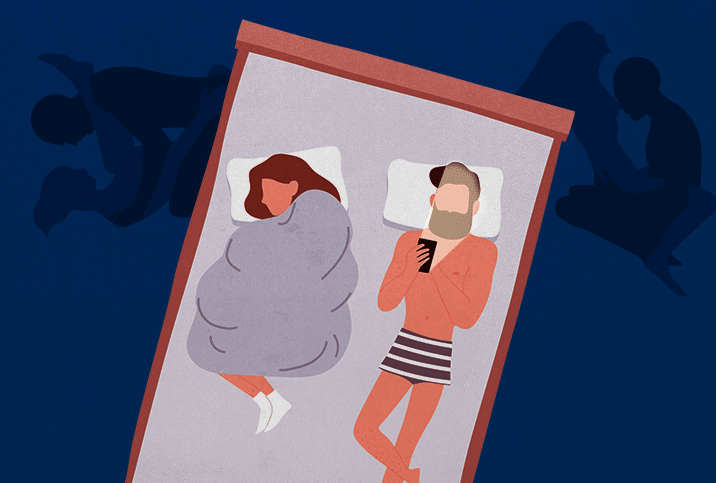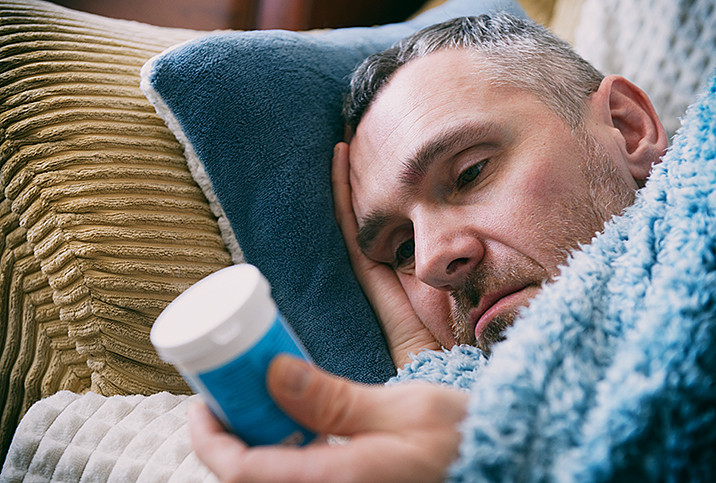Is a Lackluster Sex Drive Ruining Your Life?

Many, if not all, of us experience a drop in sexual desire at points in our lives, thanks to occurrences such as changes in hormones, age, stress (caused by something like a pandemic, maybe?) and relationship problems. Luckily, when the conflict is resolved, your desire typically returns. However, this isn't the case for millions of women who struggle with sexual dysfunction, specifically, hypoactive sexual desire disorder (HSDD).
Despite living in an age that's beginning to embrace sexual empowerment, stigma still surrounds women's sexual dysfunction. Even though HSDD is the most common sexual disorder, reported by about 5 percent to 14 percent of women, there's still a lot we don't understand about the underlying biological causes.
What is hypoactive sexual desire disorder?
HSDD is defined as persistent deficient sexual fantasies and desire for sexual activity to the point of causing distress—distress being the key word.
"Nearly 50 percent of women experience a drop in libido, and 10 percent feel it's distressing," explained Sheryl Kingsberg, Ph.D., chief of behavioral medicine in the department of obstetrics and gynecology at University Hospitals Cleveland Medical Center.
Bear in mind that the 10 percent estimate may be conservative, because many women believe their symptoms are a normal part of aging and they have to live with them.
To be classified as hypoactive sexual desire disorder, these distressing symptoms must occur for at least six months and include any of the following:
- Lack of motivation for sexual activity; decreased or absent sexual thoughts or fantasies
- Decreased or absent response to erotic stimulation or an inability to maintain arousal
- Loss of desire to initiate or participate in sexual activity
- Feelings of frustration, grief, guilt, loss, sadness or worry
HSDD has an impact well beyond sexuality: impairing self-confidence and self-worth, and creating disconnection from intimate partners. Hence, treating sexual dysfunction is so much more than just increasing libido.
Treatment options for hypoactive sexual desire disorder
Biologically, it's believed that an imbalance of neurotransmitters in the brain can contribute to a loss of sexual desire. Low serotonin levels are associated with depression, while increased levels can lower arousal. So if a woman is taking an antidepressant that increases serotonin levels, this may have an adverse effect on sexual arousal.
Kingsberg, whose primary research interests are treatments for female sexual disorders, explained that hypoactive sexual desire disorder is best understood from a biopsychosocial perspective. This means the causes can be biological (an imbalance in neurotransmitters or hormones), psychological (depression), cultural (religious belief or stigma) or interpersonal relationship conflicts.
Women's sexuality is very complex. Treatment isn't one-size-fits-all and can depend on a multitude of factors.
Medication options
The only two FDA-approved medication options available are for premenopausal women with acquired, generalized HSDD. Acquired means there have been no previous issues with sexual desire, and generalized refers to a lack of sexual desire regardless of the situation or stimulation.
Vyleesi. Approved in 2019 by the Food and Drug Administration, Vyleesi (bremelanotide) is injected into the subcutaneous fat at least 45 minutes before anticipated sexual activity, offering a potential 16-hour window of increased desire. Used "as needed" but no more than eight times per month, women can feel some control over their sexual lives.
Addyi. Addyi (flibanserin) is a once-daily pill taken at bedtime. Addyi is thought to correct the chemical imbalance in the brain that affects sexual excitement. It is imperative women do not consume alcohol within two hours of taking Addyi due to the risk of severe low blood pressure and fainting.
Rachel Rubin, M.D., a board-certified urologist and sexual medicine specialist in Maryland, and one of only a handful of physicians with fellowship training in sexual medicine for all genders, explained that these two medications work in approximately 50 percent to 60 percent of people who take them. Like all medications, they won't work for everyone, but she has found these medications to be safe and effective, and her patients have had fantastic results.
Testosterone. Although there are no FDA-approved testosterone products for women with hypoactive sexual desire disorder, numerous studies demonstrate that it is effective in very low doses (one-tenth the daily dose for men) at raising testosterone levels to the typical premenopausal range. While the other two medication options are specifically for premenopausal women, testosterone is recommended for women who are postmenopausal or transitioning into menopause.
Kingsberg described a recent encounter with a patient who was postmenopausal and began losing her desire in her 40s. She still found her husband very attractive, and their relationship was stable, but her lack of desire was a loss to her.
"She would likely be a candidate for testosterone," Kingsberg said.
Psychosocial interventions
Therapy and sexual counseling. Kingsberg was one of the authors of a 2018 article for the International Society for the Study of Women's Sexual Health, which stated: "Some women will benefit from psychotherapy alone—cognitive behavioral therapy (CBT) and mindfulness-based CBT—particularly if they are struggling with interpersonal issues, negative beliefs about sexuality, body image issues, past negative experiences or relationships conflicts."
Still, simple biology can be the culprit. While psychosocial interventions are undoubtedly important, Rubin feels this area shouldn't be the main focus.
"We don't talk about the actual biology," she noted. "These medications are helpful approaches to the hormonal and nonhormonal aspects of low libido."
More research and education are needed
There appears to be a distinct lack of recent literature to reference on the subject of HSDD. Rubin said research on women's sexual health is lagging behind that of our male counterparts. And the reason for that?
"Has a doctor ever asked you about your libido or orgasms?" she asked me rhetorically. (No, they haven't.)
Part of the problem lies in a physician failing to broach the subject, but women also remain embarrassed or ashamed to bring up the topic themselves, and may not even be aware that they can be treated for any lacking areas.
Healthcare providers play an important role in raising awareness of women's sexual dysfunction. Many clinicians lack education about this topic and may ignore or refuse to believe such issues exist. If a woman does find the courage to bring up their troubling symptoms to a doctor who isn't well-versed on treatment options or, even worse, is dismissive, this only further exacerbates the problem.
Speaking up for women's sexual dysfunction
While the slow pace and lack of funding for women's sexual studies are frustrating, there have been advancements. A large part of that progress resides in speaking up, but critically, healthcare providers must educate themselves so they feel comfortable assessing and treating sexual health problems. Women, too, have a responsibility to educate themselves and inquire about the options that are best for them.
Women deserve satisfying, fulfilling sex lives and shouldn't accept defeat due to menopause or any other transition. Each woman who seeks support and treatment for sexual dysfunction brings us one step closer to bridging the gap, raising awareness and ending sexual stigma.


















